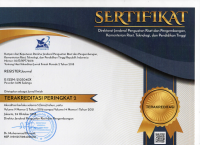This policy outlines the journal's stance on the ethical and responsible use of Artificial Intelligence {AI} and AI-assisted technologies in the preparation of manuscripts submitted for publication. This policy aims to ensure transparency, accountability, and the integrity of the scientific record.
1. Authorship and Accountability
- AI cannot be an Author: AI tools and AI-assisted technologies {e.g., Large Language Models, Generative AI} do not meet the criteria for authorship as they cannot take responsibility for the content, integrity, or originality of the work. Therefore, AI tools or software cannot be listed as authors on any submitted manuscript.
- Authors' Full Responsibility: Authors remain fully responsible and accountable for the entire content of their submitted manuscript, including any parts generated, edited, or enhanced by AI tools. This includes the accuracy, integrity, originality, and ethical soundness of the work. Authors must verify the factual correctness of any statements, citations, data, or figures generated by AI.
- Human Oversight Required: The use of AI tools must be under direct human supervision. Authors must critically evaluate, edit, and revise any material generated by AI to ensure it aligns with scientific standards, accuracy, and ethical guidelines.
2. Transparency and Disclosure
-
Mandatory Disclosure: Authors are required to disclose the use of AI and AI-assisted technologies in the preparation of their manuscript. This disclosure must be explicit, specific, and transparent.
-
What to Disclose: The disclosure should include:
- The name of the AI tool{s} used: e.g., ChatGPT {OpenAI}, Bard {Google}, Grammarly, GPT-4, Midjourney, etc.
- The specific purpose{s} for which the AI tool was used: e.g., language refinement, grammar check, drafting of specific sections {specify which sections}, brainstorming, data analysis assistance, image generation, etc.
- The extent of AI involvement: A brief description of how the AI tool contributed to the manuscript.
-
Where to Disclose: This disclosure should typically be included in one of the following sections:
- Acknowledgements section: {Preferred for general writing assistance}
- Methods section: {If AI was used for specific methodological steps, e.g., data analysis or coding assistance}
- A dedicated "Declaration of AI Use" statement just before the References section or in a footnote on the title page.
Example Disclosure Statement: "Portions of this manuscript were drafted/edited/enhanced using [Name of AI tool, e.g., ChatGPT-4 {OpenAI}]. The authors used this tool for [specific purpose, e.g., improving grammar and clarity/drafting an initial version of the Introduction section]. All content generated by the AI was thoroughly reviewed, edited, and validated by the authors, who take full responsibility for the final content." Or for image generation: "Figure X was generated with the assistance of [Name of AI tool, e.g., Midjourney v5]. The authors provided the prompts and edited the output to ensure accuracy and relevance."
3. Permissible Uses {with Disclosure}
AI tools may be used to assist authors in the following ways, provided full disclosure is made:
- Language and Grammar Refinement: Improving readability, spelling, grammar, and sentence structure.
- Drafting Support: Assisting in the generation of initial drafts of specific, non-research-critical sections {e.g., parts of the Introduction or Discussion for stylistic purposes}, which must then be thoroughly reviewed and revised by the authors.
- Brainstorming and Idea Generation: Assisting in conceptualizing ideas or outlining the structure of the manuscript.
- Data Analysis and Visualization Assistance: {Only if verified and reproducible by human authors}. If AI is used in data processing, analysis, or generating figures/tables, the specific methods, tools, and validation steps must be clearly described in the Methods section.
- Summarization of Literature: Aiding in summarizing existing literature, but the authors must ensure the accuracy of the summary and proper citation of original sources.
4. Prohibited Uses
The use of AI and AI-assisted technologies is strictly prohibited for:
- Generating Fictitious Content: Creating false data, fabricated research results, or non-existent references/citations.
- Plagiarism: Using AI-generated content without proper attribution {i.e., treating it as original work when it is not fully human-generated or verified}. All AI-generated content must be treated as any other source and properly attributed if it relies on existing intellectual property or specific datasets.
- Substituting for Human Intellectual Contribution: AI cannot perform the core intellectual work of research, such as formulating original hypotheses, designing experiments, interpreting novel findings, or drawing original conclusions.
- Violating Confidentiality: Reviewers and editors are strictly prohibited from using AI tools with confidential manuscript content {e.g., uploading the manuscript to publicly available AI models}, as this may breach confidentiality, copyright, and the integrity of the peer-review process.
- Misrepresenting Research: Using AI to intentionally mislead readers about the methods, results, or conclusions of the research.
5. Consequences of Misuse
Failure to adhere to this policy regarding the ethical use of AI and AI-assisted technologies will be considered a serious breach of publication ethics. Such breaches may result in:
- Rejection of the submitted manuscript.
- Retraction of the published article.
- Banning of the author{s} from future submissions to the journal.
- Notification to the authors' institution and relevant ethics committees.
This policy will be periodically reviewed and updated to reflect advancements in AI technology and evolving ethical guidelines in scholarly publishing.










